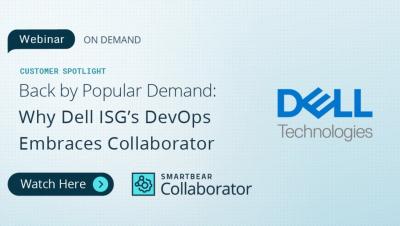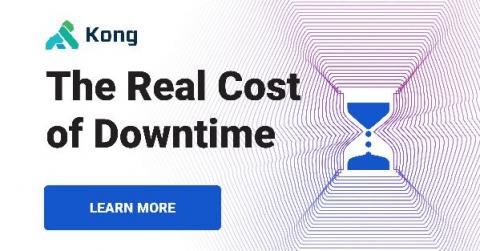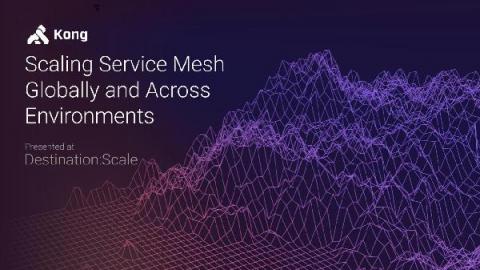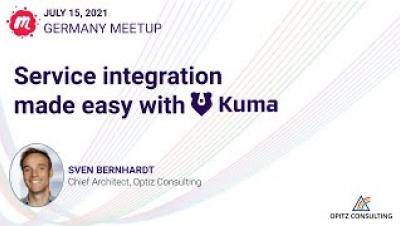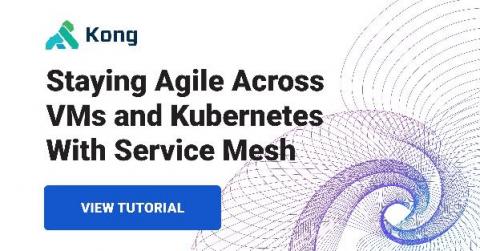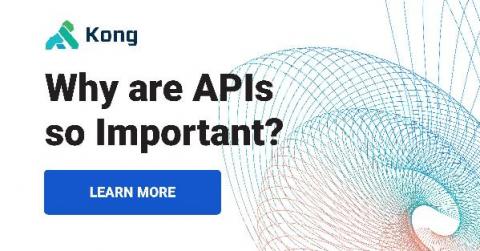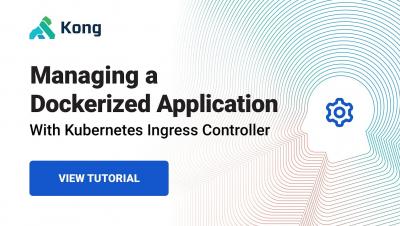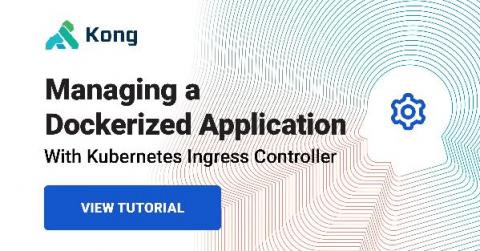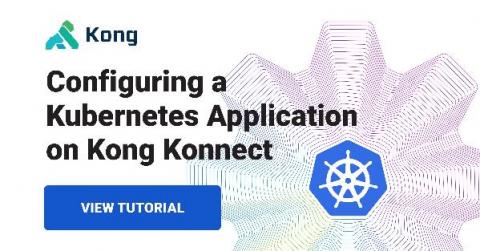Systems | Development | Analytics | API | Testing
July 2021
Understanding the Basics of Envoy Configuration
Kubernetes Ingress gRPC Example With a Dune Quote Service
APIs come in all different shapes and forms. In this tutorial, I’ll show you a Kubernetes Ingress gRPC example. I’ll explain how to deploy a gRPC service to Kubernetes and provide external access to the service using Kong’s Kubernetes Ingress Controller. And to hype you up a little bit about the upcoming live-action movie, Dune, based on Frank Herbert’s book, I created a Kubernetes service that delivers Dune quotes.
Back by Popular Demand: Why Dell ISG's DevOps Embraces Collaborator
Sevrice Connectivity & APIOps for All - Kong Tel Aviv Meetup
The Real Cost of API Downtime
Last week, the digital world experienced a power outage. A major distributed edge computing platform experienced a software bug that led to the collapse of their Domain Name System (DNS), or the Internet’s way to map domain names (i.e. united.com) to IP addresses. The consequences were costly. So what is the real cost of downtime? When a DNS system within a globally recognized edge platform fails, it causes downtime for a huge amount of international enterprises.
How to Build a REST API: Types and Requirements
Intercom APIs & DreamFactory
8 Common API Gateway Request Transformation Policies
API gateway request transformation policies are incredibly powerful. There are many situations when an API developer can take advantage of request transformations to adjust the shape and values of a request to cleanly fit their API. Let’s say you’re deprecating a certain endpoint for your API, but you still need to support the old specification for a transition period.
API Strategy Fundamentals: Nurture API Adoption
API-Led Data Integration: Key Questions to Ask When Securing an API
Scaling Service Mesh Globally and Across Environments
A true service mesh should focus on how to manage and orchestrate connectivity globally. Connecting a new service mesh for each use case is a much simpler problem to solve, but doing so won’t help you scale. You’ll just be throwing a service mesh in each cluster and calling it a day. The more appealing solution is to stitch together environments.
Scaling Down to Scale Up Using Kong's API Gateway
This blog post is part two of a two-part series on how we broke down our monolith to scale our API management with Kong Gateway, the world’s most popular open-source API gateway. (Here’s part one.) At NexJ, the pioneer of intelligent customer management with client engagement products designed for the financial services industry, we sought to capture the full addressable market by breaking down the monolith and going API-first.
APIs are Now at the Center of Digital Transformation
As we take stock of how COVID-19 has affected the way we operate, nothing in technology is more apparent than the switch to digital. Although many of us have transitioned from water-cooler conversationalists to reluctant zoom dwellers, the impact on business processes themselves might actually be more profound. According to McKinsey, coronavirus has acted as an accelerant on companies offering digital products and services.
How to Make gRPC Calls with Insomnia
6 Ways to Leverage Insomnia as a gRPC Client
In this article, we’re going to build a fun and simple gRPC server in Node.js. Then we’ll demonstrate how to use Insomnia to make gRPC requests on our server. First, let’s briefly cover some core tech concepts. If you’re already familiar with the basics, skip ahead to the tutorial or watch the video below.
NexJ Drives End-to-End Connectivity With Kong to Scale CRM Solutions
This blog post is part one of a two-part series on how our team at NexJ broke down our monolith to scale our API management with Kong Gateway, the world’s most popular open source API gateway.
Choosing an API technology: gRPC, REST, GraphQL
How do you choose an API style and API technology when you start a new project? Today, if you look at API technology research such as RapidAPI Developer Survey and Insights, you’ll probably conclude that REST is the dominant force in the API landscape. While REST is certainly well-known to most developers and used in a lot of production environments, it may not be the best fit for every scenario.
API Strategy Fundamentals: Integrate The Technology
Adopting a Product Mindset when Developing your API Ecosystem
Securing a Multitenant Database API with DreamFactory
July Germany Meetup - Service integration made easy with Kuma
Summer School At Collaborator: Session #1 - Fortify with New Features & Functionality
API Gateway Plugins for Kubernetes Ingress Controller
Online Meetup: Kong Gateway 2.5 Release
Kong Gateway (OSS) 2.5 Released
Hello, Kong Nation 👋 ! We’ve fashioned a pristine version of the Kong Gateway (OSS) 2.5, which is now available on the normal channels. Read on for more release information.
Zendesk APIs & DreamFactory
Driving API Consumption Within Your API Ecosystem
API Strategy Fundamentals: Align the Organization
DreamFactory Recognized as High Performer by G2
Staying Agile on VMs and Kubernetes With Service Mesh
Over the past ten years, Clubhouse and other innovative startups built software quickly. They started from scratch and blew past their incumbents. But the fact of the matter is that speed is no longer a differentiator. Everyone can move quickly. We’ve seen it as Facebook and Twitter quickly duplicated Clubhouse’s “innovative” functionality. Today, it’s all about agility—taking the momentum that you’ve already built up.
Why are APIs so important?
APIs have long been the programmers tool of choice for inter-application communication. Built by programmers, for programmers. Giving each other an interface and a means by which to call each other’s code. As for documentation and ease of use, well….
Deploying a Docker App with Kubernetes and Kong Ingress Controller
Managing Docker Apps With Kubernetes Ingress Controller
Think back to when your development team made the switch to Dockerized containers. What was once an application requiring multiple services on virtual machines transitioned to an application consisting of multiple, tidy Docker containers. While the result was a streamlined system, the transition likely was daunting. Now, it’s time for another transformational leap: moving from a single set of containers to a highly available, orchestrated deployment of replica sets using Kubernetes.
Webflow APIs & DreamFactory
Configuring a Kubernetes Application on Kong Konnect
Hello, everyone! Viktor Gamov, a developer advocate with Kong here. In this article, I would like to show you how to set up service connectivity using Kong Konnect and Kubernetes. I will deploy an application in Kubernetes, configure a runtime through Konnect and demonstrate some management capabilities like enabling plugins. Let’s dive right in!
MS3 Supports 10K+ Transactions/Second With Kong Gateway and Kuma Service Mesh
MS3 specializes in enterprise integration software, cloud migration strategies and API enablement. I’ve worked at MS3 for about five years. For the last year, I’ve been the principal product manager for Tavros, an enterprise integration platform from MS3. This article will dive into how we’re leveraging Kong Gateway and Kuma service mesh in Tavros.
2021: The Year Banks Rethink Their API Strategy
Co-authored by Samta Bansal More than two million British people use Open Banking-based products today, a number that, despite the disruption of COVID-19, is double that seen at the start of 2020. No wonder International Banker dubbed 2021 “The Year of Open Banking.” As open banking spreads worldwide, its growth comes with the pressing need to drive standardization that bridges geographic boundaries and regulatory frameworks.





